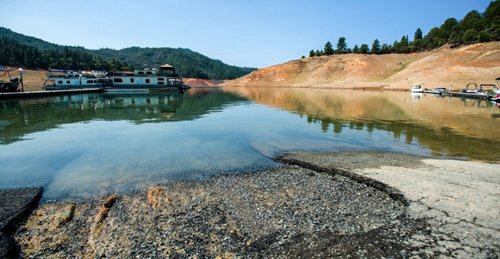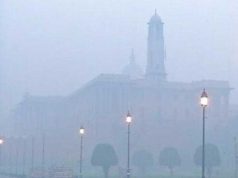The atmospheric conditions associated with the unprecedented drought currently afflicting California are “very likely” linked to human-caused climate change, Stanford scientists write in a new research paper.
In a new study, a team led by Stanford climate scientist Noah Diffenbaugh used a novel combination of computer simulations and statistical techniques to show that a persistent region of high atmospheric pressure hovering over the Pacific Ocean that diverted storms away from California was much more likely to form in the presence of modern greenhouse gas concentrations.

The research, published on September 29 as a supplement to the month’s issue of the Bulletin of the American Meteorological Society, is one of the most comprehensive studies to investigate the link between climate change and California’s ongoing drought.
“Our research finds that extreme atmospheric high pressure in this region – which is strongly linked to unusually low precipitation in California – is much more likely to occur today than prior to the human emission of greenhouse gases that began during the Industrial Revolution in the 1800s,” said Diffenbaugh, an Associate Professor of Environmental Earth System Science at Stanford and a senior fellow at the Stanford Woods Institute for the Environment.
The exceptional drought currently crippling California is by some metrics the worst in state history. Combined with unusually warm temperatures and stagnant air conditions, the lack of precipitation has triggered a dangerous increase in wildfires and incidents of air pollution across the state. A recent report estimated that the water shortage would result in direct and indirect agricultural losses of at least $2.2 billion and lead to the loss of more than 17,000 seasonal and part-time jobs in 2014 alone. Such impacts prompted California Governor Jerry Brown to declare a drought emergency and the federal government to designate all 58 California counties as “natural disaster areas”.
Scientists agree that the immediate cause of the drought is a particularly stubborn “blocking ridge” over the northeastern Pacific – popularly known as the Ridiculously Resilient Ridge, or “Triple R” – that prevented winter storms from reaching California during the 2013 and 2014 rainy seasons.
Blocking ridges are regions of high atmospheric pressure that disrupt typical wind patterns in the atmosphere. “Winds respond to the spatial distribution of atmospheric pressure,” said Daniel Swain, a graduate student in Diffenbaugh’s lab and lead author of the study. “We have seen this amazingly persistent region of high pressure over the northeastern Pacific for many months now, which has substantially altered atmospheric flow and kept California largely dry.”
Blocking ridges occur periodically at temperate latitudes, but the Triple R was exceptional for both its size and longevity. While it dissipated briefly during the summer months of 2013, it returned even stronger by fall 2013 and persisted through much of the winter, which is normally California’s wet season.
“At its peak in January 2014, the Triple R extended from the subtropical Pacific between California and Hawaii to the coast of the Arctic Ocean north of Alaska,” said Swain, who coined the term “ridiculously resilient ridge” last fall to highlight the unusually persistent nature of the offshore blocking ridge.
Like a large boulder that has tumbled into a narrow stream, the Triple R diverted the flow of high-speed air currents known as the jet stream far to the north, causing Pacific storms to bypass not only California but also Oregon and Washington. As a result, rain and snow that would normally fall on the West Coast was instead re-routed to Alaska and as far north as the Arctic Circle.
An important question for scientists and decision-makers has been whether human-caused climate change has influenced the conditions responsible for California’s drought. Given the important role of the Triple R, Diffenbaugh’s team set out to measure the probability of such extreme ridging events.
The team first assessed the rarity of the Triple R in the context of the 20th-century historical record. They found that the combined persistence and intensity of the Triple R in 2013 was unrivalled by any event since 1948, which is when comprehensive information about the circulation of the atmosphere is first available.

















